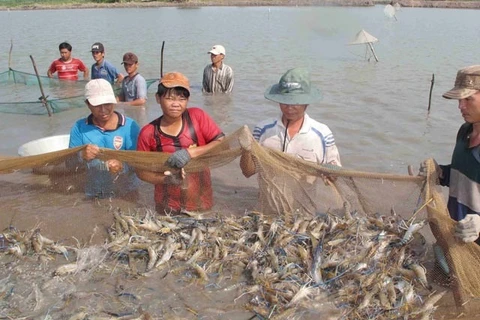 Agro-forestry-fishery sector's export revenue hit 40.02 billion USD in 2018 (Illustrative image. Photo: VietnamPlus)
Agro-forestry-fishery sector's export revenue hit 40.02 billion USD in 2018 (Illustrative image. Photo: VietnamPlus) Hanoi (VNA) – Although Vietnam’s agro-forestry-fishery sector grew 3.76 percent in 2018, the sector is operating below its potential.
Last year, Vietnam recorded GDP growth of 7.08 percent, with 8.7 percent contributed by the agro-forestry-fishery sector.
The sector’s export revenue in the year hit 40.02 billion USD.
However, the sector has yet to optimise its advantages in various aspects such as weather conditions, geographic location, human resources and opportunities from free trade agreements.
Experts said the Government should reform its policies and create mechanisms to aid hi-tech agricultural firms’ growth, while designing models to connect farmers and create products with high content of technology, thus helping Vietnamese agriculture secure a position in the international market.
Seeking way out of small-scale production
Seeing agriculture as an advantage of Vietnam, the Party and State have designed various policies to promote the development of the sector and rural areas.
In implementing the resolution of the 10th Party Central Committee’s seventh plenum on agriculture, farmer and rural area, the Government directed ministries, sectors and localities to carry out many programmes, proposals, mechanisms and policies comprehensively. Therefore, the agricultural sector has seen progress with continuous growth.
However, at a conference to review the sector’s performance in 2018, Minister of Agriculture and Rural Development Nguyen Xuan Cuong pointed out that agriculture and rural areas of Vietnam faced many difficulties that need tackling.
80 percent of farmer households engage in small-scale production
With farmers used to traditional manual production methods, the introduction of the Fourth Industrial Revolution worries many.
“We have applied this method for generations. If not done manually, how can the soil be prepared for sowing?” said Nguyen Ngoc Binh, a farmer in An Phu commune, Kinh Mon district of Hai Duong province.
This mindset is common among the farmers who are hard-working and used to the heat of sunlight and freezing cold weather.
Nguyen Van Tien, head of the Department of Agriculture-Rural Area under the Party Central Committee’s Economic Commission, said small-scale agricultural production with loose connection and cooperation has made it difficult to promote mechanization and modernisation in agricultural production.
Currently, 80 percent of farmers engage in small-scale production with less than one hectare of farmland per household. The farmers’ average monthly income is only 2.4 million VND, noted Tien.
According to Minister of Agriculture and Rural Development Nguyen Xan Cuong, although agricultural restructuring has seen positive results, the implementation of the work is uneven among localities. Moreover, production in the form of value chains connecting businesses and farmers has yet to become popular, thus small-scale production has still been the majority model. This is the reason for the weakness of agriculture, which hinders the expansion of large-scale agricultural production in Vietnam.
How to form connection?
To form large-scale fields, the merging of fields has been implemented over the years. However, Prof. Dr. Tran Duc Vien from the Vietnam Academy of Agriculture Sciences pointed to a different picture in Japan, where farmers still cultivate their own small fields. Instead, they follow the “Noukyou” model, a form of cooperative, in which farmers with nearby fields connect with each other to enhance the quality and productivity of crops.
The Noukyou has the task of organising production and linking up with businesses to ensure markets for farm produce and higher income for farmers. Meanwhile, the government designs policies to benefit farmers, but doesn’t interfere with their operations, he said.
Vien noted that farmers only account for 3 percent of Japan’s population, but they can supply abundant food and foodstuff to more than 127 million Japanese people, and even export their products thanks to the application of high technology and effective value chains.
Another linkage model was introduced by the Sustainable Rice Platform (SRP), which was applied in Vietnam during the summer-autumn crop 2018. The SRP and the Sat4Rice project have expanded the use of an app to provide information to farmers during all stages of rice production to all 3,518 farmer households with 10,836 hectares of material rice region of the Loc Troi Group in the Mekong Delta region.
The Mekong Rice Research Institute and the Loc Troi Group have signed an agreement to transfer cultivation technology and two new rice varieties to farmers.
Chairman of the Management Board and General Director of Loc Troi Group Huynh Van Thon said that thanks to the activities, the profits of farmers have increased by an additional 2.8 million VND per hectare.
Thon attributed the results to the connection model which helps farmers apply technological advances to the production process, thus improving product quality and safety, improving the trademark and competitiveness of businesses, reducing production costs and increasing incomes. Notably, the production environment has improved thanks to the reduction of pollution, increasing the sustainability of agricultural production.
Lessons from the past have shown that small-scale, unplanned and unconcentrated production make farmers vulnerable to global market developments. This is why the agriculture sector frequently needs a “rescue”.
Prof. Tran Duc Vien stressed the necessity to develop civilised rural areas, proposing that management agencies build mechanisms to collect and analyse data to support farmers in making production decisions in a most effective manner.
“Vietnam needs to build and develop an identification system serving new-style rural area in 2021-2030, which include indicators of living quality, satisfaction of locals. It is also necessary to set up a database for the agricultural sector to support the decision-making in the process of agricultural production and business managing and directing as well as rural developing,” suggested Prof. Vien.-VNA
























